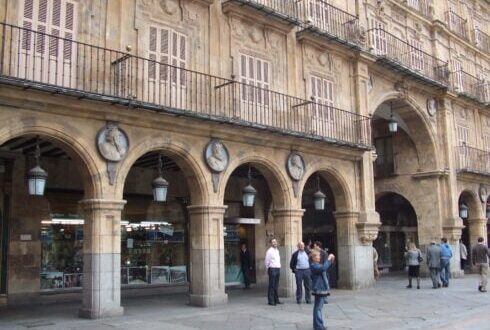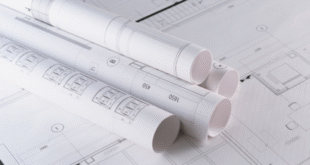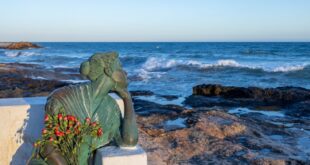TO call Salamanca’s Plaza Mayor ‘just’ a city square, the little word ‘just’ has to pull off a heroic shift.
This is not an overstatement. The Plaza, a stunning piece of architectural design, is quite possibly one of the most beautiful places in the world.
Construction started on May 10th 1720. The urban environment was never the same again.
Each side of this elegant rectangle stretches about 80 metres (260 feet), and while it gives off a vibe of flawless symmetry, the truth is – it’s faking it. The façades are out by up to a metre. It’s a delightful bit of architectural magic.
And here’s one of its better-kept secrets: among the carved medallions lining the square is a bust of… Franco. Yes, it’s that Franco.
Salamanca served as his base in the first year of Spanish Civil War. Decades later, someone was able to sneak his likeness onto a decorative piece, next to Saint Teresa of Avila.

In these days, the city would prefer that you did not notice. But someone clearly does, because the bust is regularly vandalised – spray-painted, defaced, you name it – and then painstakingly scrubbed clean. It gets a guard for big anniversaries.
You’ll often hear the Plaza called la plaza dorada – the golden square – thanks to the honey-toned Villamayor stone it’s built from. It will glow when sunlight is reflected just so.
Pavillions refers to the four arcades that surround it. Keep an eye out for the Pavilion of the Petrineros – that’s where Salamanca’s leather artisans worked, back when a well-made saddle was as essential as a good cup of coffee.
Architecturally, one challenge was the lovely but inconvenient medieval church of San Martín, sitting squarely in the way. It was a sacrilege to knock it down.Instead of tearing it down (sacrilege! Spanish pragmatism at its best.
The design of a double tower for the townhall was scrapped. The ground was unable to support the weight. But not to worry – it got relocated to the nearby Iglesia de la Clerecía. It’s there for you to admire.
There are 88 arches total. Have you got kids with you? Set them the mission of finding the number 88, hidden beneath an arch in the Lienzo de San Martín vault. (Spoiler Alert: it is there.)
Then there are another 477 balconies. This is not a typo.


There’s an inscription under the main archway of the Royal Pavilion that is sobering: “A woman has been killed here.” Pray for her. Year 1838.” No one knows for sure what happened. Legend says that the reddish veins in the column near her are her bloodstains.
READ MORE
Sit back with a cold beer and take in the Town Hall façade. Some windows are “blind” – they’re fake, part of the design to keep everything visually balanced. It wasn’t a father who was overprotective and bricked up his daughter. It was just the rhythm of symmetry.
Bullfights once roared across this square. One side was even built with continuous balconies – residents insisted on them, knowing they could cash in by renting out the view for corridas. The square could hold up to 20,000 people at its height. Earning a doctorate from the local university in the 19th century came with an odd rite of passage. You had to pay for a bullfight at Plaza Mayor.
Stop by Café Novelty while you’re here. It’s the oldest establishment in the square and is a great place to listen in on politicians or poets.
And if you’re lucky, you’ll catch a “Tuna” group – students dressed in 16th-century garb, strumming lutes and guitars, singing Spanish folk tunes in flawless harmony. Give them a tip – they’re scholars, not street performers (but also: they really need the money).
Oh – and if you see people lying flat on their backs in the centre of the square, don’t worry. The people are trying to see the four sides of the square at once. Local lore claims that if you can do it, it will bring good luck.
You should give it a go, don’t ya think?
 Costa News Spain Breaking News | English News in Spain.
Costa News Spain Breaking News | English News in Spain.





